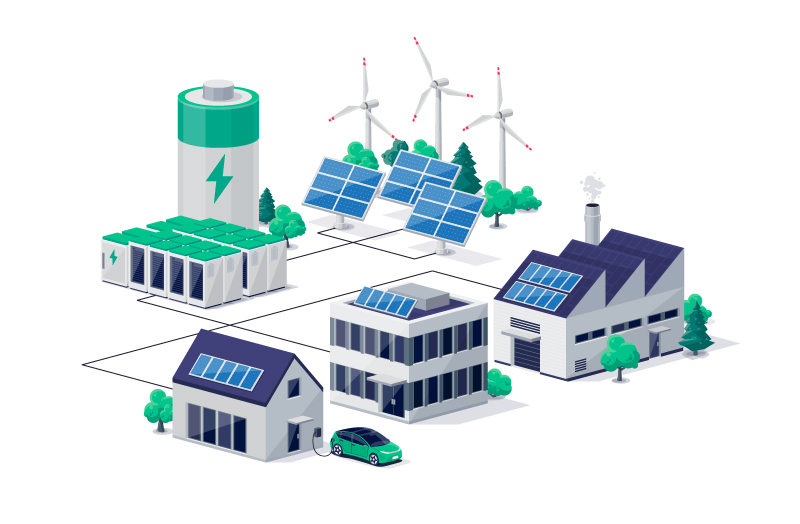Microgrids Offer Resilience, Energy Conservation, and Off-Grid Capabilities
An answer to the question “what is a microgrid?” can be simple or involved.
Keeping it simple, the definition of a microgrid is a localized energy grid that allows the user control. This means the grid can be connected or disconnected to or from the traditional electrical grid and operate independently.
But a more involved answer includes factors such as energy conservation, resilience, and protection against power outages. When combined with renewable energy sources, microgrids have the capacity to be a main feature of the continued momentum toward grid autonomy.
The United States Department of Energy Microgrid Exchange Group defined microgrids as ‘‘a group of interconnected loads and distributed energy resources within clearly defined electrical boundaries that acts as a single controllable entity with respect to the grid. A microgrid can connect and disconnect from the grid to enable it to operate in both grid-connected and island-mode.”
Major benefits include:
- Grid modernization
- Utilization of numerous technologies
- Reduction of peak load
Of course, to meet the electricity demands a microgrid requires a generation source as well as a controller. Historically, these generation sources came in the form of gas-powered generators.
But with the continuing economization of solar and the obvious environmental benefits, many of today’s microgrids are fueled, so to speak, by a combination of solar plus battery storage.
The Inspiration for Microgrids
Whether you’re powering a small business, a college campus, or anything in between the concept of grid autonomy continues to gain momentum.
Major storms impact the United States on a regular basis, most recently over the holiday season when driving blizzards, winds, and record cold temperatures drove many communities, including the city of Nashville, Tennessee to implore residents and business to reduce or eliminate their electricity usage during peak hours for several days.
That’s the beauty of a microgrid – the ability to disconnect from the main grid doesn’t imply a necessity. In other words, you can remain connected to the grid for periods of time or even the majority of the time.
But when it’s advantageous – during peak hours, for example, or in the case of a long-lasting power outage or period of voluntary conservation, such as the one in Nashville – you have the ability to go off the grid with no sacrifice.
Examples of Microgrids
After Hurricane Maria ravaged Puerto Rico in 2017, communities began switching to microgrid technology and gained the ability to keep the power on for days, even months at a time during the ensuing outages and again in the aftermath of last fall’s Hurricane Fiona.
If a microgrid can power a community for months at a time in the wake of a devastating storm, it goes without saying how it can benefit a smaller, unconventional community where outages are simply not an option – for example, a hospital – even for short amounts of time.
Microgrids and Energy Conservation
Grid independence is one aspect of a cleaner, greener style of living. But powering your microgrid with via renewable sources of energy is the other half of the equation, and it’s where the greatest advances are occurring.
Conventional microgrids of the past may have been powered via fossil fuels or gas-powered generators, but today’s action plans from local, state, and even national entities demand a renewable approach to creating microgrids and potential ‘islanding.’
In 2021, the Department of Energy created an online database to track microgrids installed throughout the United States. As you can see, these microgrids are located predominantly in California, Texas, and the Mid-Atlantic and New England regions.
More importantly, however, they’re used to potentially power landmarks from elementary schools in Eugene, Oregon, to the University of Michigan’s Central Power Plant in Ann Arbor. They’re also used to power medium-sized businesses such as a Wal-Mart in Snyder, Texas.
Using a microgrid doesn’t mean going ‘off the grid’ entirely – it just gives your community or business the ability to do so when it’s convenient, practical, or necessary without having to sacrifice. Microgrids allow for flexibility, cost savings, and an environmentally conscious approach to energy needs.









